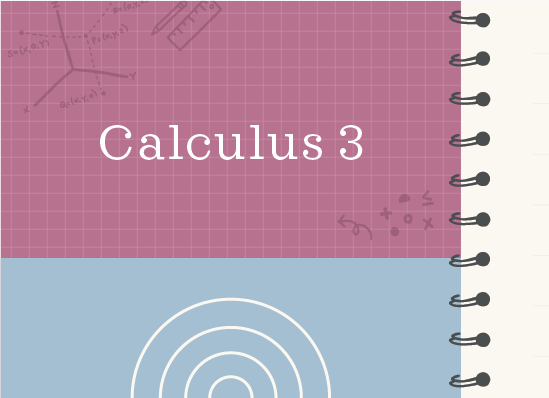Finding volume with double integrals in polar coordinates
Setting up double integrals in polar coordinates
To evaluate a double polar integral, we’ll need to make sure that both function and the limits of integration are in terms of polar coordinates ???(r,\theta)???.
Hi! I'm krista.
I create online courses to help you rock your math class. Read more.
If we’re given a double integral in rectangular coordinates and asked to evaluate it as a double polar integral, we’ll need to convert the function and the limits of integration from rectangular coordinates ???(x,y)??? to polar coordinates ???(r,\theta)???, and then evaluate the integral.
To change the function and limits of integration from rectangular coordinates to polar coordinates, we’ll use the conversion formulas
???x=r\cos{\theta}???
???y=r\sin{\theta}???
???r^2=x^2+y^2???
Remember also that when you convert ???dA??? or ???dy\ dx??? to polar coordinates, it converts as
???dA=dy\ dx=r\ dr\ d\theta???
How to evaluate a double integral in polar coordinates
Take the course
Want to learn more about Calculus 3? I have a step-by-step course for that. :)
Using the double integral in polar coordinates to find the volume of a solid
Example
Use a double polar integral to find the volume of the solid enclosed by the given curves.
???z=\sqrt{x^2+y^2+4}???
???z=4???
First, we’ll convert both functions to polar coordinates and get
???z=\sqrt{r^2+4}???
???z=4???
Now we want to set the equations equal to each other to get points of intersection, so that we can figure out the limits of integration.
???\sqrt{r^2+4}=4???
???r^2+4=16???
???r^2=12???
???r=\pm\sqrt{12}???
???r=\pm2\sqrt{3}???
Since ???r??? represents distance from the origin in the polar system, and radius can’t be negative, we change the ???-2\sqrt{3}??? to ???0??? and we can say that the limits of integration for ???r??? are ???0\le{r}\le2\sqrt{3}???.
Next we can solve for the limits of integration with respect to ???\theta???. Since we got ???r^2=12???, which is the same as ???x^2+y^2=12???, we know the region is a circle, which means the limits of integration for ???\theta??? will be a full ???360^\circ???, or ???0\le\theta\le2\pi???.
Now we need to build our function. We need to figure out which function is further from the origin (has the outer radius) and which one is closer to the origin (has the inner radius). We know that ???z=4??? will always stay the same, no matter what the value of ???r???. But the value of ???z=\sqrt{r^2+4}??? can change, depending on the value of ???r??? that we choose. If we plug in the upper and lower limits of integration, we get
???z=\sqrt{\left(\sqrt{12}\right)^2+4}???
???z=\sqrt{16}???
???z=4???
and
???z=\sqrt{(0)^2+4}???
???z=\sqrt4???
???z=2???
Since ???z=\sqrt{r^2+4}??? will sometimes have a value smaller than ???z=4??? (since we just found that ???z=2??? when we substitute ???r=0???), we’ll treat ???z=4??? as the outer function and ???z=\sqrt{r^2+4}??? as the inner function. Therefore, we get
???V=\int\int_D\left(4-\sqrt{r^2+4}\right)r\ dr\ d\theta???
Adding the limits of integration, we get
???V=\int^{2\pi}_0\int^{2\sqrt{3}}_0\left(4-\sqrt{r^2+4}\right)r\ dr\ d\theta???
???V=\int^{2\pi}_0\int^{2\sqrt{3}}_04r-r\sqrt{r^2+4}\ dr\ d\theta???
We need to figure out which function is further from the origin (has the outer radius) and which one is closer to the origin (has the inner radius).
Now we’ll evaluate the integral by splitting it into two separate integrals so that we can use u-substitution on the second one.
???V=\int^{2\pi}_0\int^{2\sqrt{3}}_04r\ dr\ d\theta-\int^{2\pi}_0\int^{2\sqrt{3}}_0r\sqrt{r^2+4}\ dr\ d\theta???
???u=r^2+4???
???du=2r\ dr???
???dr=\frac{du}{2r}???
???V=\int^{2\pi}_02r^2\Big|^{r=2\sqrt{3}}_{r=0}\ d\theta-\int^{2\pi}_0\int^{r=2\sqrt{3}}_{r=0}r\sqrt{u}\left(\frac{du}{2r}\right)\ d\theta???
???V=\int^{2\pi}_02r^2\Big|^{r=2\sqrt{3}}_{r=0}\ d\theta-\int^{2\pi}_0\int^{r=2\sqrt{3}}_{r=0}\frac12u^\frac12\ du\ d\theta???
???V=\int^{2\pi}_02r^2\Big|^{r=2\sqrt{3}}_{r=0}\ d\theta-\int^{2\pi}_0\frac12\left(\frac23\right)u^\frac32\Big|^{r=2\sqrt{3}}_{r=0}\ d\theta???
???V=\int^{2\pi}_02r^2\Big|^{r=2\sqrt{3}}_{r=0}\ d\theta-\int^{2\pi}_0\frac13(r^2+4)^\frac32\Big|^{r=2\sqrt{3}}_{r=0}\ d\theta???
???V=\int^{2\pi}_02\left(2\sqrt{3}\right)^2-2(0)^2\ d\theta-\int^{2\pi}_0\frac13\left[\left(2\sqrt{3}\right)^2+4\right]^\frac32-\frac13\left[(0)^2+4\right]^\frac32\ d\theta???
???V=\int^{2\pi}_02(12)\ d\theta-\int^{2\pi}_0\frac13\left(12+4\right)^\frac32-\frac13\left(4\right)^\frac32\ d\theta???
???V=\int^{2\pi}_024\ d\theta-\int^{2\pi}_0\frac13\left(16\right)^\frac32-\frac13\left(4\right)^\frac32\ d\theta???
???V=\int^{2\pi}_024\ d\theta-\int^{2\pi}_0\frac13\left(64\right)-\frac13\left(8\right)\ d\theta???
???V=\int^{2\pi}_024\ d\theta-\int^{2\pi}_0\frac{64}3-\frac83\ d\theta???
???V=\int^{2\pi}_024\ d\theta-\int^{2\pi}_0\frac{56}3\ d\theta???
Now we’ll put the integrals back together.
???V=\int^{2\pi}_024-\frac{56}3\ d\theta???
???V=\int^{2\pi}_0\frac{72}3-\frac{56}3\ d\theta???
???V=\int^{2\pi}_0\frac{16}3\ d\theta???
And then we’ll integrate with respect to ???\theta???.
???V=\frac{16}3\theta\Big|^{2\pi}_0???
???V=\frac{16}3(2\pi)-\frac{16}3(0)???
???V=\frac{32\pi}3???
This is the volume of the solid enclosed by the curves.






